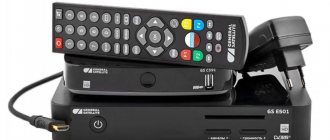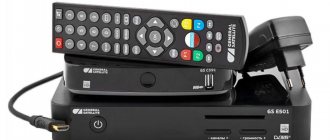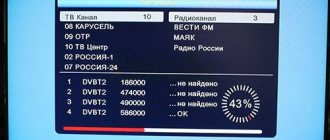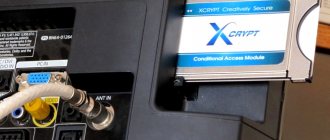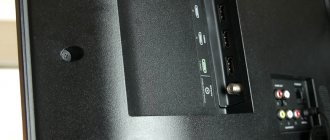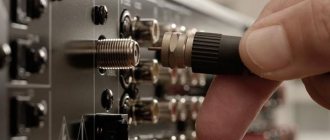Why do some sellers advise purchasing a voltage stabilizer when buying a TV? How to choose this unit, and is it really necessary? Abrupt power outages and power surges are unpleasant, but common. Jumps most often occur:
- when the cable breaks;
- when using powerful equipment (for example, a welding machine for construction);
- temporary power outage.
What is a voltage stabilizer?
This is a special device designed to analyze the incoming voltage and equalize it, if necessary, up or down, converting it to standard 220V.
According to the principle of action, stabilizers are:
- Relay. Transformer-type units that are capable of converting indicators with small jumps. With a high voltage drop, the device itself often fails. As a rule, such devices are low in cost.
- Electromechanical or servo-drive devices for equalizing voltage levels. These devices are capable of leveling out small range jumps, while the operating speed of such a device is also low. They differ from models of the first type in their compact size and slightly longer service life.
- Stabilizers with electronic control system. As a rule, models of this type of units are the most expensive, but they provide excellent operating speed and are capable of equalizing voltage readings with large deviations from the 220V norm.
How to connect the selected model to TV
The 220V voltage stabilizer is connected according to the standard switching scheme for household appliances. It must be grounded. The stabilizer fork has a corresponding contact. In apartments built according to modern standards, it is enough to plug the device into a power outlet.
In old houses and private housing constructions, the electrical wiring diagram does not have a ground wire. For this case, there is a separate terminal on the device body. It is recommended to connect it to an external grounding system. For example, a group of steel rods driven into the ground around the perimeter of a building.
Important! Without this precaution, the device must not be used. If a breakdown occurs on the housing without grounding, the unit may catch fire or become a source of electrical injury.
And connecting the TV is as simple as possible: its plug is inserted into the socket on the stabilizer body. This completes all switching work.
Voltage regulation devices for different types of TVs
Some buyers mistakenly believe that if you choose a voltage stabilizer for LCD TVs, then it cannot be used, for example, for a plasma receiver. Actually this is not true. Regulators are universal units capable of connecting to any type of equipment, including any type of TV. Any of the representatives of the devices for regulating current intensity indicators can be used to connect to any TV. The choice of the type of regulator depends only on the power of the TV. So, for various stereo systems and home theaters you will need a more powerful unit than for a regular TV. At the same time, there are special models of such devices from the manufacturers Phillips, LG, Samsung themselves, but they often have a cost significantly higher than the cost of a regular stabilizer.
Old tube TVs
The adult generation remembers very well that in the USSR under every TV there was a plastic box called a “voltage stabilizer” that was sure to hum. The box, as a rule, was hot and necessarily heavy.
Of course, TVs could work without these boxes, but any deviation of the voltage in the outlet from 220V led to the image on the screen changing its brightness and saturation, and the picture itself changing in size. So almost everyone had stabilizers.
Such stabilizers worked using the principle of supersaturation of the transformer core and therefore were designed for a narrow range of load powers .
For black-and-white TVs with a power of 100-200 W, some models of stabilizers were produced, and for color TVs - completely different, more powerful ones. It was impossible to include a low-power load in a powerful stabilizer, because in this case, the very principle of its operation was violated and it ceased to perform its function.
Here, for example, is an excerpt from the instruction manual for the Soviet Vega-9 voltage stabilizer:
Allowable output power of the stabilizer: - minimum 100, - maximum 200 W.
Permissible input voltage fluctuations are 154…253 V. Stabilized output voltage is 198…231 V.
Efficiency - 84%. Stabilizer weight 3.4 kg.
As you can see, there was a limitation on the load power from below, i.e. It was impossible to turn on a small black-and-white TV with a power of less than 100 W in such a stabilizer. More precisely, it was possible to turn it on, but in this case one could forget about any voltage stabilization.
If you plug a load of more than 200W into Vega-9 (for example, a color TV of those times), then the stabilizer is guaranteed to overheat and the plastic case begins to melt and stink. I have seen such melted boxes from other people more than once.
By the way, today such old stabilizers for old TVs are called ferroresonant. Today's devices are often assembled using an autotransformer circuit with a large number of taps and triac switching between them.
What to look for when choosing a stabilizer?
In order for the purchase of an additional device to be justified, and the stabilizer to serve for a long time, it is necessary to take into account some points:
- Determine how necessary it is to purchase such a device. If surges in current intensity are small or occur extremely rarely, then some power supplies are quite capable of withstanding them. In this case, you can get by with the protective system of the unit itself.
- It is advisable to look for a device with additional protection against short circuits and a system for cleaning the network from interference.
- Dimensions of the device.
- Methods of connecting to the network and devices.
- Noise level during operation.
- Device power. One of the important indicators, since if the power of the control device is less than that of the TV, then the meaning of this purchase will be reduced to zero. Therefore, before choosing a stabilizer, you need to see what the power of the TV is. Typically, such information is indicated in the technical data sheet or on the back of the case. Based on the power rating of the TV or its power supply, you need to choose a stabilizer that has more power.
- The number of connected equipment representatives and their total power value. In order to connect the regulation system to several devices, it is necessary to summarize the power indicators of all devices and, based on this data, select a voltage regulator.
Varieties
There are several subtypes of electrical stabilizers for TV:
- relay type system;
- servomotor mechanism or mechanical;
- triac system;
- voltage stabilizer with double conversion capability - they may differ in properties and internal design.
Relay systems
The most common due to their low cost are relay systems. They belong to the class of autotransformer stabilizers. In simple terms, the output transformation occurs in parallel with the input transformation. The system does not require maintenance. It can withstand a fifteen percent drop.
The downside may be the limited resource: the wear of the stabilizer is directly proportional to the frequency of surges in the network. Among other things, the sound produced during operation can be quite loud. Users who have already used a similar scheme do not speak highly of this model, but as a temporary option it is quite suitable.
Mechanical system
A higher position is occupied by a stabilizer, which has resources and characteristics superior to a relay circuit. This is a servomotor mechanism, or as it is also called, an electromechanical stabilization circuit. The cost of the device may significantly exceed previous generation systems, but it also surpasses them in terms of resistance.
Of course, there were some downsides. The servomotor mechanism works quite slowly. In addition, if you give preference to this subclass of stabilizers, you will be faced with the need to periodically visit the workshop. Consumables - brushes - require frequent replacement, which can cause some inconvenience.
Stabilizer Luxeon LDS-10000
Triac
In addition to those already described, the following type of voltage stabilizers has managed to earn great popularity. The triac system is quite common among owners of household appliances. This is a good stabilizer, the service life of which is from three to five years. The circuit has no moving parts, which allowed the designers to achieve silent operation. Such a device does not require special maintenance and does an excellent job of equalizing voltage.
The weak point of the stabilizer can be high temperature - as a rule, thyristors fail due to excess heat. This type of failure is caused by network interference.
The increased characteristics of the triac stabilizer determine its considerable price, but it is justified by its long service life and high efficiency - 98%. In addition, triac stabilizers are the fastest, their response speed to voltage surges is 10 ms. High accuracy rates, instant response to an emergency, a wide range of incoming voltage, all this without further ado makes you choose such an effective device.
Triac voltage stabilizer LVT ASN-350S
Double conversion
Stabilizers of this type are more effective than relay and mechanical systems. They operate on the principle of inverter devices. The key advantage is the ability to convert AC to DC and vice versa. High accuracy of current conversion is achieved by installing a special microprocessor in the circuit.
Such stabilizers are ideal for installation in equipment with a power of 1-30 kW, sensitive to voltage surges - this includes LCD TVs. They are durable (work up to 15 years), practically silent, and quickly respond to emergency situations.
However, the cost of such devices is not small: prices for individual copies can reach 60 thousand rubles.
Do not forget that the purchase of each of the listed voltage equalization devices in household appliances is just reinsurance. It is likely that you will never need it, and your money will be wasted. As mentioned earlier, most TVs are already equipped with standard voltage stabilizers. The purchase will be relevant only for devices of the previous generation - tube or transistor models with no autovoltage mechanism. It’s up to you to decide which one to choose – cheap or expensive.
Inverter type voltage stabilizer Sibkontakt IBPS-12-600N
Review of regulator models and their characteristics
This review presents models of inexpensive devices costing from 1,500 to 6,000 rubles.
- DefenderAVRInitial series 1000. Inexpensive automatic regulator with a power of 320 W. Equipped with a protection system against overheating and overloads, as well as a built-in surge protector. Compact device with an indicator of the current network status.
- DefenderAVR model iPOWER A medium-sized electronic device with a power of 300 W. Provides high speed and silent operation.
- SvenNeo R 600. Stabilizer capable of converting current intensity to 220V with an input value from 150 to 280V. The device is equipped with an additional function for filtering high-frequency interference. Which is especially important for such sensitive devices as televisions. This device automatically shuts down when overloaded, overheated or short-circuited.
- Uniel STR500 power 300 W. Convenient and compact regulator with a maximum power of 300 W. Capable of equalizing current intensity in the network from 145 to 280V at the input. Equipped with an indicator that shows the operating voltage and overload status.
It should be noted that purchasing regulators for each individual type of equipment is not advisable. Therefore, to ensure protection against shocks for all household appliances in the house, it is better to purchase a more powerful wall stabilizer. Such devices are distinguished by high power (about 8000 W) and are able to withstand significant voltage changes and loads.
If we are only talking about protecting an expensive TV or home theater, then in this case it is better to purchase a special small power regulator which will be enough for one device. Some television receivers have built-in stabilizers, but the power supplies of modern televisions are unable to fully protect the device from sudden and significant voltage surges. Therefore, purchasing a stabilizer will probably significantly extend the life of the device.
Modern TVs and stabilizers
All modern household appliances, including TVs of the 3rd generation and newer, have switching power supplies capable of operating in a wide range of input voltages.
On imported TV models released after 2000, something like 110-260V AC is usually written on the back cover. At the same time, a stable voltage is always maintained at the output of such a power supply, which powers all components of the TV.
So, if your TV was manufactured after 1985 (not to mention models from 2017), then it does not need a stabilizer at all . Leave it in the store.
And don’t listen to the convincing assurances of TV sellers that a stabilizer for your new TV is simply absolutely necessary. The seller has only one task - to sell you as many extras as possible for your TV.
Short circuit and pixel burnout
He will tell you tales about how LCD TVs “burn out pixels” from power surges, how LED TVs burn out LEDs, how stabilizers protect your TV from short circuits, interference, direct hits from nuclear weapons, and other nonsense. Don't listen!
A short circuit will do absolutely nothing to your TV (unless, of course, the short circuit occurs in the TV itself). In the event of a short circuit somewhere on the line, the current will simply flow along a different path and the TV will be de-energized (i.e. it will simply turn off). That's all the terrible and terrible consequences of short circuit.
As for pixel burnout, I have the following to say. Firstly, the “pixels” themselves do not burn out at all; the control transistors that “light up” these same pixels fail. If the transistor burns out, the pixel remains extinguished forever (black dot), and if the transistor breaks, then the pixel always glows (bright dot on the screen).
The most interesting thing is that it doesn’t matter whether you have a stabilizer or not, pixels can and will fly out. This happens simply according to the theory of system reliability (just imagine how many of them there are, these pixels!).
Since we are talking about pixels, this means that this is an LCD TV, which means it has a switching power supply, therefore, voltage surges in the network do not have any effect on the voltage in the TV circuit itself.
In this way, voltage stabilization is already carried out inside the TV circuit, therefore, buying another stabilizer is nothing more than a waste of money.
The outlet voltage is too low or too high
You may ask, what happens if the voltage in the network goes beyond the permissible values indicated on the TV nameplate? It's simple. If the voltage gets too low , the TV will simply turn off. Without consequences. After the voltage returns to normal values, the TV can be turned on again as usual.
It's worse if the voltage gets too high . Then a breakdown of a special element at the TV input - a varistor - will occur. A broken varistor causes a real short circuit, as a result of which the fuse blows and the circuit is de-energized. This is overvoltage protection. After some time, the varistor returns to normal; all that remains is to replace the fuse. By the way, self-resetting fuses are now used.
So, as you can see, a modern TV provides protection against all major dangers. There is absolutely no point in buying a stabilizer specifically for TV.
Network filters
The only thing your TV may need is a good surge protector . And even then only in some cases. All switching power supplies already contain an RF filter at the input (this, by the way, is done to ensure that high-frequency interference from a working pulse generator does not penetrate the network and interfere with the operation of other electrical devices), but sometimes it is still not enough. And then an external surge filter will help get rid of interference.
However, here you need to be sure that interference penetrates into the TV through the power supply circuits, and not through the antenna, for example. In the latter case, the surge protector will be completely useless; it is better to focus on finding a high-quality antenna with good side-lobe suppression.
Uninterruptible power supplies
an uninterruptible power supply in addition to the TV . But you and I are smart, we know that uninterruptible power supplies are designed to maintain the functionality of equipment in the event of a power outage. They are indispensable for devices such as desktop computers, some medical equipment, network equipment from providers, etc. But why do TVs need uninterruptible power supplies?! So that you can finish watching the comedy club or what? A very dubious waste of money.
How uninterruptible power supplies are connected
Voltage stabilizers for TVs are connected according to the general principle. No additional knowledge or skills are required for external devices. Most models have 5 connectors: input phase, neutral, ground zero, phase, going to the load point.
You can connect devices only when the power supply to the house is turned off. It is advisable to install an auxiliary RCD before the meter to extend the life of the uninterruptible power supply. A grounding loop is provided in the electrical network itself.
Important! You cannot monitor the stabilizer immediately in front of the counter. The optimal installation location is 0.5 meters from the TV, but not closer.
The connection diagram is simple - the stabilizer is plugged into an outlet. And the TV into the device socket marked “output”. The TV can only be turned on after all elements have been connected.
In which network can deviations and overvoltages occur?
The problem with the quality of electricity is most acute in the private sector, dacha cooperatives and suburban areas. The electrical network there, firstly, is more worn out and more often overloaded, and secondly, it is more vulnerable to negative natural influences, such as thunderstorms, freezing rain or hurricanes.
Electricity parameters in a private home can change several times a day. For a difference to occur, it is enough, for example, for a neighbor to turn on a welding machine or a powerful pump. If, as a result of such or any other fluctuations, the mains voltage reaches values exceeding the maximum permissible value for the TV, then there is no need to doubt - the device needs protection!
Residents of large cities are also familiar with power supply problems; in particular, periodic power surges bother consumers living near large industrial enterprises. In addition, no one is immune from network accidents resulting from man-made incidents or the notorious human factor.
Note!
In absolutely any network, a deviation can occur and, even worse, extreme overvoltage. Therefore, a device capable of neutralizing harm from such phenomena will never be superfluous. Even if there is no vital need for it right now, it is impossible to predict how the power grid will behave in the next hour, day, month!
Agree, it is extremely disappointing to have a modern smart TV costing tens of thousands of rubles break down due to a momentary overvoltage caused by a break in the neutral wire in the socket or an error by an electrician who incorrectly twisted the cables somewhere in the external panel.
Selection rules
When choosing which voltage stabilizer is best, you should pay attention not only to the manufacturer, but also to several important parameters.
- Phasing. Single-phase models are great for use at home and connecting household appliances, computers, TVs, etc. to them. Three-phase equipment is often used in industry with three-phase current consumers (380 V).
- Power. One of the most important parameters when choosing a stabilizer. To select the appropriate power, it is necessary to take into account the total load of all connected devices, as well as which input circuit breaker is installed in the phase.
- Precision stabilization. This parameter shows the maximum possible output voltage drop. According to GOST, it should be a maximum of 10% of the nominal value. In most modern models, the stabilization accuracy is 3-8%.
- Availability of indication. Modern stabilizers are distinguished by various indicators, thanks to which you can find out and analyze the characteristics of the device. These could be LED bulbs or user-friendly displays.
- Efficiency value. The higher this indicator, the greater the energy savings.
- Response time to changes in input voltage. The longer the response time of the stabilizer, the more dangerous voltage changes are for electrical appliances.
Now, knowing the best voltage stabilizers and the criteria for their selection, it will not be difficult to choose the right one depending on your requirements.
Found a typo? Select the text and press Ctrl + Enter
Connection
Installation and commissioning must be carried out by a professional. A mandatory step is grounding. A copper wire is led from the housing to the grounding bus. This is required to protect users from electric shock. Electromagnetic background harmful to humans is also reduced.
On the subject: Which hotels in Olonets attract tourists
As a result, the equipment will be protected from breakdowns in accidents. It also warns of impulse noise. In apartment buildings and private buildings, single-phase and three-phase devices are used.
Exploitation
There are certain rules on how to use an uninterruptible power supply for a TV.
- Do not leave the device turned on all the time, this may cause overheating, and the circuit simply will not withstand it;
- Any circuit breaker must be checked periodically, this is done by carrying out load and capacity tests;
- Even the best stabilizer cannot be kept in close proximity to household appliances, because These electronic devices generate their own magnetic field, which can negatively affect the operation of home appliances.

